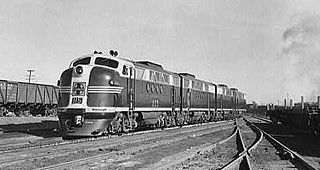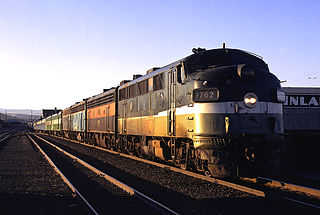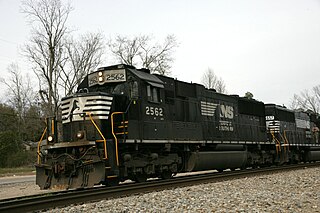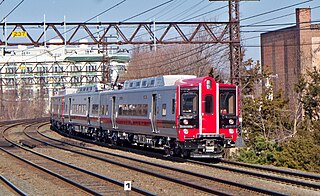
Metro-North Railroad, trading as MTA Metro-North Railroad, is a suburban commuter rail service operated by the Metropolitan Transportation Authority (MTA), a public authority of the U.S. state of New York. Metro-North serves the New York Metropolitan Area, running service between New York City and its northern suburbs in New York and Connecticut, including Port Jervis, Spring Valley, Poughkeepsie, Yonkers, New Rochelle, Mount Vernon, White Plains, Southeast and Wassaic in New York and Stamford, New Canaan, Danbury, Bridgeport, Waterbury, and New Haven in Connecticut. Service in Connecticut is operated under contract with the Connecticut Department of Transportation. Metro-North also provides local rail service within the New York City boroughs of Manhattan and the Bronx.

The New York, New Haven and Hartford Railroad, commonly known as The Consolidated, or simply as the New Haven, was a railroad that operated principally in the New England region of the United States from 1872 to December 31, 1968. Founded by the merger of the New York and New Haven and Hartford and New Haven railroads, the company had near-total dominance of railroad traffic in Southern New England for the first half of the 20th century.

Brookville Equipment Corporation, based in Brookville, Pennsylvania, United States, manufactures railroad locomotives for industrial and light capacity switching needs. The company also builds and restores streetcars. The company used to be known as Brookville Locomotive Company.

The EMD F40PH is a four-axle 3,000–3,200 hp (2.2–2.4 MW) B-B diesel-electric locomotive built by General Motors Electro-Motive Division in several variants from 1975 to 1992. Intended for use on Amtrak's short-haul passenger routes, it became the backbone of Amtrak's diesel fleet after the failure of the EMD SDP40F. The F40PH also found widespread use on commuter railroads in the United States and with VIA Rail in Canada. Additional F40PH variants were manufactured by Morrison-Knudsen and MotivePower between 1988 and 1998, mostly rebuilt from older locomotives.

The EMD FT is a 1,350-horsepower (1,010 kW) diesel-electric locomotive that was produced between March 1939 and November 1945, by General Motors' Electro-Motive Corporation (EMC), later known as GM Electro-Motive Division (EMD). The "F" stood for Fourteen Hundred (1400) horsepower and the "T" for Twin, as it came standard in a two-unit set. The design was developed from the TA model built for the C,RI&P in 1937, and was similar in cylinder count, axle count, length, and layout. All told 555 cab-equipped ”A” units were built, along with 541 cabless booster or ”B” units, for a grand total of 1,096 units. The locomotives were all sold to customers in the United States. It was the first model in EMD's very successful F-unit series of cab unit freight diesels and was the locomotive that convinced many U.S. railroads that the diesel-electric freight locomotive was the future. Many rail historians consider the FT one of the most important locomotive models of all time.

The EMD F3 is a 1,500-horsepower (1,100 kW) B-B freight- and passenger-hauling carbody diesel locomotive produced between July 1945 and February 1949 by General Motors’ Electro-Motive Division. Final assembly was at GM-EMD's La Grange, Illinois plant. A total of 1,111 cab-equipped lead A units and 696 cabless booster B units were built.

The EMD SD70 is a series of diesel-electric locomotives produced by the US company Electro-Motive Diesel. This locomotive family is an extension and improvisation to the EMD SD60 series. Production commenced in late 1992 and since then over 5,700 units have been produced; most of these are the SD70M, SD70MAC, and SD70ACe models. While the majority of the production was ordered for use in North America, various models of the series have been used worldwide. All locomotives of this series are hood units with C-C trucks, except the SD70ACe-P4 and SD70MACH which have a B1-1B wheel configuration, and the SD70ACe-BB, which has a B+B-B+B wheel arrangement.

The EMD FL9 is a model of electro-diesel locomotive, capable of operating either as a traditional diesel-electric locomotive or as an electric locomotive powered from a third rail. Sixty units were built between October 1956 and November 1960 by General Motors Electro-Motive Division for the New York, New Haven and Hartford Railroad.

The EMD SD90MAC is a model of 6,000 hp (4,470 kW) C-C diesel-electric locomotive produced by General Motors Electro-Motive Division (EMD). It is, with the SD80MAC, one of the largest single-engined locomotives produced by EMD, surpassed only by the dual-engined DDA40X.

The SD45 is a six-axle diesel-electric locomotive class built by General Motors Electro-Motive Division between 1965 and 1971. It has an EMD 645E3 twenty-cylinder engine generating 3,600 hp (2,680 kW) on the same frame as the SD38, SD39, SD40, and SDP40. As of 2023, most SD45s have been retired, scrapped or rebuilt to SD40-2 standards.

The New Haven Line is a 72.7 mi (117.0 km) commuter rail line operated by the Metro-North Railroad in the U.S. states of New York and Connecticut. Running from New Haven, Connecticut, to New York City, the New Haven Line joins the Harlem Line in Mount Vernon, New York, and continues south to Grand Central Terminal in Manhattan. The New Haven Line carries 125,000 passengers every weekday and 39 million passengers a year. The busiest intermediate station is Stamford, with 8.4 million passengers, or 21% of the line's ridership.

The Danbury Branch is a diesel branch of the Metro-North Railroad's New Haven Line in the U.S. state of Connecticut, running from downtown Norwalk north to Danbury. It opened in 1852 as the Danbury and Norwalk Railroad. Until the early 1970s, passenger service continued north from Danbury to Canaan, Connecticut, and Pittsfield, Massachusetts. Metro-North took over operation of the line from Conrail in 1983, and the modern-day branch is mostly single-tracked.

The Waterbury Branch is a branch of the Metro-North Railroad's New Haven Line, running north from a junction in the Devon section of Milford to Waterbury, Connecticut. Originally built as the Naugatuck Railroad, it once continued north to Winsted. The part north of Waterbury is now leased from CTDOT by the Railroad Museum of New England, which operates excursion trains from Thomaston station through their operating subsidiary Naugatuck Railroad ; this name was chosen in homage of the original railroad. The trackage ends in Torrington, but Metro-North service on the branch ends at Waterbury. There are conceptual plans to extend service from its current terminus in Waterbury to Hartford via Bristol and New Britain. Currently, riders that want to continue to New Britain and Hartford have to transfer to an express bus operated by CTtransit at Waterbury. All trains on this branch operate as shuttles between Waterbury and Bridgeport.

The EMD F40C is a 6-axle 3,200 horsepower (2.4 MW) diesel-electric locomotive built by General Motors Electro-Motive Division in 1974 for commuter service in Chicago. EMD only built 15 locomotives; the decline of the 6-axle design for passenger service led to the adoption of the 4-axle EMD F40PH as the standard passenger locomotive in the United States. Along with a small fleet of HEP-equipped EMD SD70MAC locomotives operating on the Alaska Railroad, the F40Cs were the last six-axle passenger locomotives in daily service in North America until the delivery of Metra's first SD70MACH in 2022.

The Budd SPV-2000 is a self-propelled diesel multiple unit railcar built by the Budd Company between 1978 and 1981 for use on North American commuter railroads. The design was a successor to Budd's popular Rail Diesel Car (RDC) but based on the body of the Amfleet passenger car. It did not prove a success: Budd built 31 cars and they proved mechanically unreliable.

The U34CH is a 3,600 hp (2,700 kW) passenger diesel locomotive built by General Electric between 1970 and 1973. In total, 33 U34CH units were built; 32 were built for the New Jersey Department of Transportation and operated by the Erie Lackawanna Railway and, later, Conrail, with the last unit coming as a later rebuild of a GE U30C for the New York MTA.

The passenger locomotives derivatives of the General Motors EMD GP40 diesel-electric locomotive have been, and continue to be, used by multiple passenger railroads in North America. For passenger service, the locomotives required extra components for providing steam or head-end power (HEP) for heating, lighting and electricity in passenger cars. Most of these passenger locomotives were rebuilt from older freight locomotives, while some were built as brand new models.

The Dash 8 Series is a line of diesel-electric freight locomotives built by GE Transportation. It replaced the Dash 7 Series in the mid-1980s, and was superseded by the Dash 9 Series for freight usage and the Genesis Series for passenger usage in the mid-1990s.
The Metro-North Railroad is a commuter railroad serving northern suburbs of New York City. It principally uses a fleet of electric railcars for its services; diesel locomotives and push-pull coaches are in use as well for non-electrified portions of the system.

The Southern California Railway Museum, formerly known as the Orange Empire Railway Museum, is a railroad museum in Perris, California, United States. It was founded in 1956 at Griffith Park in Los Angeles before moving to the former Pinacate Station as the "Orange Empire Trolley Museum" in 1958. It was renamed "Orange Empire Railway Museum" in 1975 after merging with a museum then known as the California Southern Railroad Museum, and adopted its current name in 2019. The museum also operates a heritage railroad on the museum grounds.



















